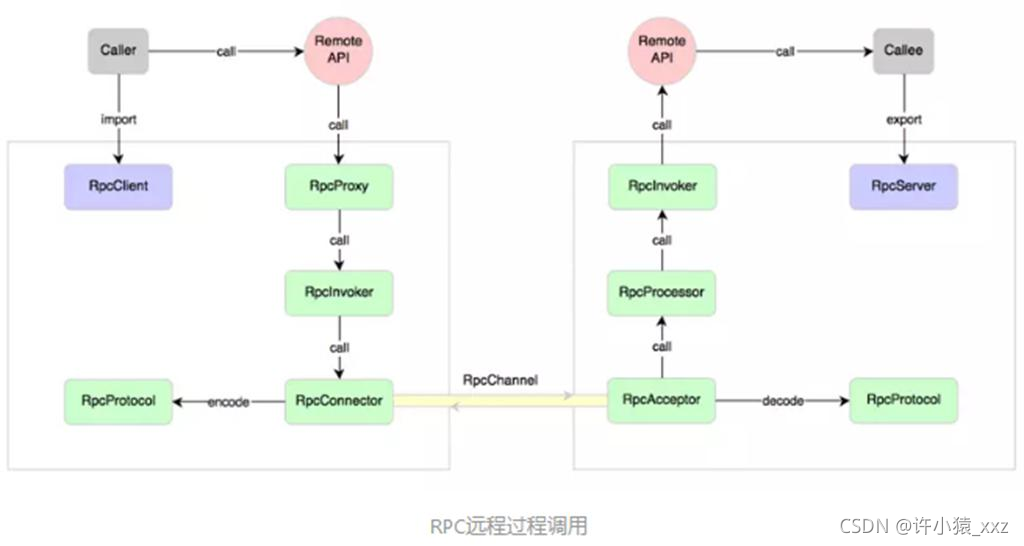一、什么是RPC?
1.1 RPC基本介绍
- RPC(Remote Procedure Call)— 远程过程调用,是一个计算机通信协议。该协议允许运行于一台计算机的程序调用另一台计算机的子程序,而程序员无需额外地为这个交互作用编程
- 两个或多个应用程序都分布在不同的服务器上,它们之间的调用都像是本地方法调用一样(如图)

3) 常见的 RPC 框架有: 比较知名的如阿里的Dubbo、google的gRPC、Go语言的rpcx、Apache的thrift,Spring旗下的 Spring Cloud。

1.2 RPC 调用流程图

1.3 RPC调用流程说明
- 服务消费方(client)以本地调用方式调用服务
- client stub 接收到调用后负责将方法、参数等封装成能够进行网络传输的消息体
- client stub 将消息进行编码并发送到服务端
- server stub 收到消息后进行解码
- server stub 根据解码结果调用本地的服务
- 本地服务执行并将结果返回给 server stub
- server stub 将返回导入结果进行编码并发送至消费方
- client stub 接收到消息并进行解码
- 服务消费方(client)得到结果
小结:RPC 的目标就是将 2-8 这些步骤都封装起来,用户无需关心这些细节,可以像调用本地方法一样即可完成远程服务调用
二、 自己实现dubbo RPC(基于Netty)
2.1 需求说明
- dubbo 底层使用了 Netty 作为网络通讯框架,要求用 Netty 实现一个简单的 RPC 框架
- 模仿 dubbo,消费者和提供者约定接口和协议,消费者远程调用提供者的服务,提供者返回一个字符串,消费
者打印提供者返回的数据。底层网络通信使用 Netty 4.1.20
2.2 设计说明
- 创建一个接口,定义抽象方法。用于消费者和提供者之间的约定。
- 创建一个提供者,该类需要监听消费者的请求,并按照约定返回数据。
- 创建一个消费者,该类需要透明的调用自己不存在的方法,内部需要使用 Netty 请求提供者返回数据
- 开发的分析图

2.3 代码实现
各类的结构图如下:

2.3.1 公共类编写
HelloService 类代码
package com.rpcNetty.publicInterface;
//这个是接口,是服务提供方和 服务消费方都需要
public interface HelloService {
String hello(String mes);
}
HelloServiceImpl 类代码
package com.rpcNetty.publicInterface;
public class HelloServiceImpl implements HelloService {
private static int count = 0;
//当有消费方调用该方法时, 就返回一个结果
@Override
public String hello(String mes) {
System.out.println("收到客户端消息=" + mes);
//根据 mes 返回不同的结果
if (mes != null) {
return "你好客户端, 我已经收到你的消息 [" + mes + "] 第" + (++count) + " 次";
} else {
return "你好客户端, 我已经收到你的消息 ";
}
}
}
2.3.2 Netty类包编写
NettyServer 类代码
package com.rpcNetty.netty;
import io.netty.bootstrap.ServerBootstrap;
import io.netty.channel.ChannelFuture;
import io.netty.channel.ChannelInitializer;
import io.netty.channel.ChannelPipeline;
import io.netty.channel.EventLoopGroup;
import io.netty.channel.nio.NioEventLoopGroup;
import io.netty.channel.socket.SocketChannel;
import io.netty.channel.socket.nio.NioServerSocketChannel;
import io.netty.handler.codec.string.StringDecoder;
import io.netty.handler.codec.string.StringEncoder;
public class NettyServer {
public static void startServer(String hostName, int port) {
startServer0(hostName, port);
}
//编写一个方法,完成对 NettyServer 的初始化和启动
private static void startServer0(String hostname, int port) {
EventLoopGroup bossGroup = new NioEventLoopGroup(1);
EventLoopGroup workerGroup = new NioEventLoopGroup();
try {
ServerBootstrap serverBootstrap = new ServerBootstrap();
serverBootstrap.group(bossGroup, workerGroup)
.channel(NioServerSocketChannel.class)
.childHandler(new ChannelInitializer<SocketChannel>() {
@Override
protected void initChannel(SocketChannel ch) throws Exception {
ChannelPipeline pipeline = ch.pipeline();
pipeline.addLast(new StringDecoder());
pipeline.addLast(new StringEncoder());
pipeline.addLast(new NettyServerHandler()); //业务处理器
}
}
);
ChannelFuture channelFuture = serverBootstrap.bind(hostname, port).sync();
System.out.println("服务提供方开始提供服务~~");
channelFuture.channel().closeFuture().sync();
} catch (Exception e) {
e.printStackTrace();
} finally {
bossGroup.shutdownGracefully();
workerGroup.shutdownGracefully();
}
}
}
NettyServerHandler 类代码
package com.rpcNetty.netty;
import com.rpcNetty.customer.ClientBootstrap;
import com.rpcNetty.publicInterface.HelloServiceImpl;
import io.netty.channel.ChannelHandlerContext;
import io.netty.channel.ChannelInboundHandlerAdapter;
//服务器这边 handler 比较简单
public class NettyServerHandler extends ChannelInboundHandlerAdapter {
@Override
public void channelRead(ChannelHandlerContext ctx, Object msg) throws Exception {
//获取客户端发送的消息,并调用服务
System.out.println("msg=" + msg);
//客户端在调用服务器的 api 时,我们需要定义一个协议
//比如我们要求 每次发消息是都必须以某个字符串开头 "HelloService#hello#你好"
if (msg.toString().startsWith(ClientBootstrap.providerName)) {
String result = new HelloServiceImpl().hello(msg.toString().substring(msg.toString().lastIndexOf("#")
+ 1));
ctx.writeAndFlush(result);
}
}
@Override
public void exceptionCaught(ChannelHandlerContext ctx, Throwable cause) throws Exception {
ctx.close();
}
}
NettyClient 类代码
package com.rpcNetty.netty;
import io.netty.bootstrap.Bootstrap;
import io.netty.channel.ChannelInitializer;
import io.netty.channel.ChannelOption;
import io.netty.channel.ChannelPipeline;
import io.netty.channel.nio.NioEventLoopGroup;
import io.netty.channel.socket.SocketChannel;
import io.netty.channel.socket.nio.NioSocketChannel;
import io.netty.handler.codec.string.StringDecoder;
import io.netty.handler.codec.string.StringEncoder;
import java.lang.reflect.Proxy;
import java.util.concurrent.ExecutorService;
import java.util.concurrent.Executors;
public class NettyClient {
//创建线程池
private static ExecutorService executor =
Executors.newFixedThreadPool(Runtime.getRuntime().availableProcessors());
private static NettyClientHandler client;
private int count = 0;
//编写方法使用代理模式,获取一个代理对象
public Object getBean(final Class<?> serivceClass, final String providerName) {
return Proxy.newProxyInstance(Thread.currentThread().getContextClassLoader(),
new Class<?>[]{serivceClass}, (proxy, method, args) -> {
System.out.println("(proxy, method, args) 进入...." + (++count) + " 次");
//{} 部分的代码,客户端每调用一次 hello, 就会进入到该代码
if (client == null) {
initClient();
}
//设置要发给服务器端的信息
//providerName 协议头 args[0] 就是客户端调用 api hello(???), 参数
client.setPara(providerName + args[0]);
//
return executor.submit(client).get();
});
}
//初始化客户端
private static void initClient() {
client = new NettyClientHandler();
//创建 EventLoopGroup
NioEventLoopGroup group = new NioEventLoopGroup();
Bootstrap bootstrap = new Bootstrap();
bootstrap.group(group)
.channel(NioSocketChannel.class)
.option(ChannelOption.TCP_NODELAY, true)
.handler(
new ChannelInitializer<SocketChannel>() {
@Override
protected void initChannel(SocketChannel ch) throws Exception {
ChannelPipeline pipeline = ch.pipeline();
pipeline.addLast(new StringDecoder());
pipeline.addLast(new StringEncoder());
pipeline.addLast(client);
}
}
);
try {
bootstrap.connect("127.0.0.1", 7000).sync();
} catch (Exception e) {
e.printStackTrace();
}
}
}
NettyClientHandler 类代码
package com.rpcNetty.netty;
import io.netty.channel.ChannelHandlerContext;
import io.netty.channel.ChannelInboundHandlerAdapter;
import java.util.concurrent.Callable;
public class NettyClientHandler extends ChannelInboundHandlerAdapter implements Callable {
private ChannelHandlerContext context;//上下文
private String result; //返回的结果
private String para; //客户端调用方法时,传入的参数
//与服务器的连接创建后,就会被调用, 这个方法是第一个被调用(1)
@Override
public void channelActive(ChannelHandlerContext ctx) throws Exception {
System.out.println(" channelActive 被调用 ");
context = ctx; //因为我们在其它方法会使用到 ctx
}
//收到服务器的数据后,调用方法 (4)
//
@Override
public synchronized void channelRead(ChannelHandlerContext ctx, Object msg) throws Exception {
System.out.println(" channelRead 被调用 ");
result = msg.toString();
notify(); //唤醒等待的线程
}
@Override
public void exceptionCaught(ChannelHandlerContext ctx, Throwable cause) throws Exception {
ctx.close();
}
//被代理对象调用, 发送数据给服务器,-> wait -> 等待被唤醒(channelRead) -> 返回结果 (3)-》5
@Override
public synchronized Object call() throws Exception {
System.out.println(" call1 被调用 ");
context.writeAndFlush(para);
//进行 wait
wait(); //等待 channelRead 方法获取到服务器的结果后,唤醒
System.out.println(" call2 被调用 ");
return result; //服务方返回的结果
}
//(2)
void setPara(String para) {
System.out.println(" setPara ");
this.para = para;
}
}
2.3.3 服务端代码
ServerBootstrap 类代码
package com.rpcNetty.provider;
import com.rpcNetty.netty.NettyServer;
//ServerBootstrap 会启动一个服务提供者,就是 NettyServer
public class ServerBootstrap {
public static void main(String[] args) {
//代码代填..
NettyServer.startServer("127.0.0.1", 7000);
}
}
2.3.4 客户端代码
ClientBootstrap 代码
package com.rpcNetty.customer;
import com.rpcNetty.netty.NettyClient;
import com.rpcNetty.publicInterface.HelloService;
public class ClientBootstrap {
//这里定义协议头
public static final String providerName = "HelloService#hello#";
public static void main(String[] args) throws Exception {
//创建一个消费者
NettyClient customer = new NettyClient();
//创建代理对象
HelloService service = (HelloService) customer.getBean(HelloService.class, providerName);
for (; ; ) {
Thread.sleep(2 * 1000);
//通过代理对象调用服务提供者的方法(服务)
String res = service.hello("你好 dubbo~");
System.out.println("调用的结果 res= " + res);
}
}
}
2.4 启动并观察结果
分别启动ServerBootstrap 的main()方法和ClientBootstrap的main()方法,观察结果如图:


到此就结束了,希望各位看官一键三连,给点支持哈🙏🙏🙏
💥推荐阅读💥






















 963
963











 被折叠的 条评论
为什么被折叠?
被折叠的 条评论
为什么被折叠?










